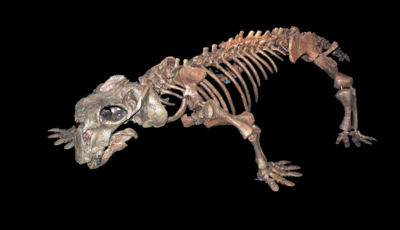ARTICLE AD BOX

Hibernation is a survival trick used by animals like bears, bats, and squirrels to cope with harsh winters, and surprisingly, this biological response has been around for far longer than we could think!Hibernation is a quality that can be found stretching back hundreds to millions of years.
An interesting new study reveals that hibernation might not be a recent adaptation at all, but a deeply ancient one that dates back to a time before dinosaurs ruled the Earth.Researchers studying fossils from a pig-sized creature have found unbelievable signs that this animal may have hibernated much like warm-blooded animals do today. Shockingly, this creature lived around 250 million years ago.This discovery opens up a completely new window into how early animals may have survived extreme environments, especially near the poles.A recent study has found fossils dating back 250 million years. This pig-like creature is known as Lystrosaurus, a four-legged animal that lived during the Triassic period and is considered an early relative of mammals.What makes this discovery remarkable is that researchers have found signs suggesting that Lystrosaurus may have entered a hibernation-like state, much like some animals do today to cope with extreme seasonal changes.
According to vertebrate paleontologist Megan Whitney from Harvard University, “These preliminary findings indicate that entering into a hibernation-like state is not a relatively new type of adaptation.
It is an ancient one.”, he said in a study named Evidence of torpor in the tusks of Lystrosaurus from the Early Triassic of Antarctica

The secret to finding this information came from the animal's continuously growing tusks, which resemble the behaviour of tree rings, leaving behind a physical record of growth.
By slicing and examining tusks from six Lystrosaurus fossils found in Antarctica and comparing them with four others from South Africa, scientists spotted a clear pattern. The Antarctic tusks showed repeated signs of slowed growth and stress, which could be signals similar to those found in modern animals that hibernate.“To see the specific signs of stress and strain brought on by hibernation, you need to look at something that can fossilise and was growing continuously during the animal's life,” said Christian Sidor, a biologist at the University of Washington, in a press statement to the University of Washington news.
“Many animals don't have that, but luckily Lystrosaurus did.”This behavior is known as torpor, allowing animals to slow their metabolism and conserve energy during harsh conditions. While Antarctica was warmer during the Triassic period, it still had long stretches of darkness in winter, making hibernation a useful survival strategy.

The fossil evidence doesn't definitively prove that Lystrosaurus hibernated, but it is currently the oldest hint of hibernation-like behavior we have.
According to the study, the stress patterns in the Antarctic tusks are similar to “small metabolic reactivation events during a period of stress,” said Whitney. “What we observed in the Antarctic Lystrosaurus tusks fits a pattern… most similar to what we see in warm-blooded hibernators today.
”They suggest that having a flexible physiology that is capable of adjusting to changing seasons or environmental stress might have helped species like Lystrosaurus survive extreme events like mass extinctions.Scientists have continued to explore the ancient roots of hibernation, in this discovery that might even help in research into applying these principles to human medicine, in areas like trauma recovery and space travel.



.png)
.png)
.png)
















 1 day ago
3
1 day ago
3









 English (US) ·
English (US) ·